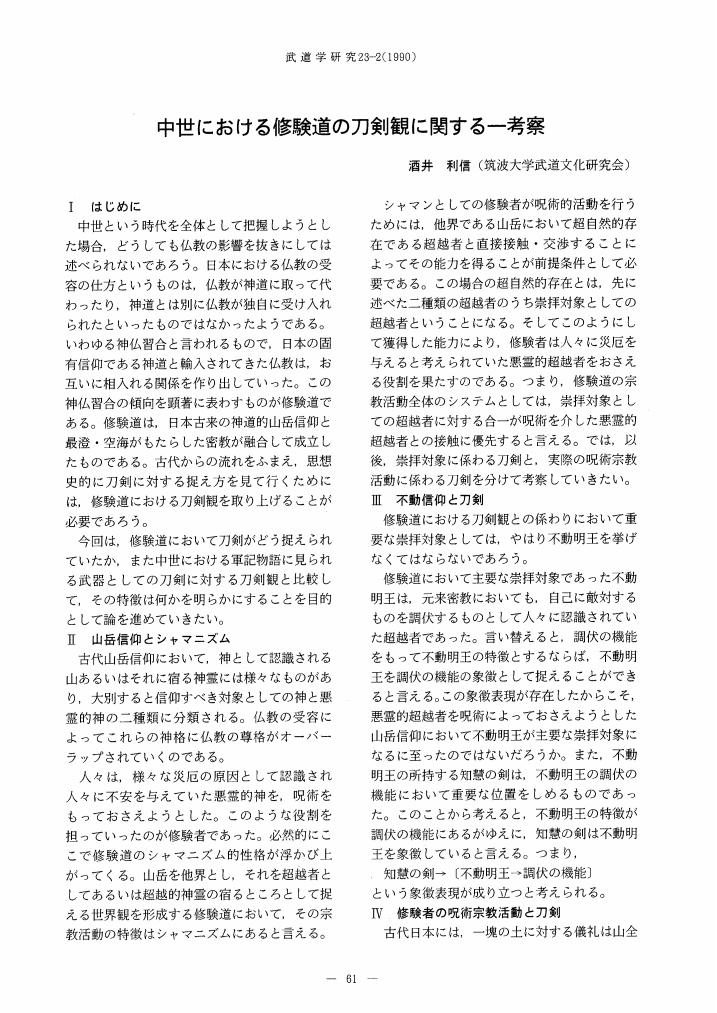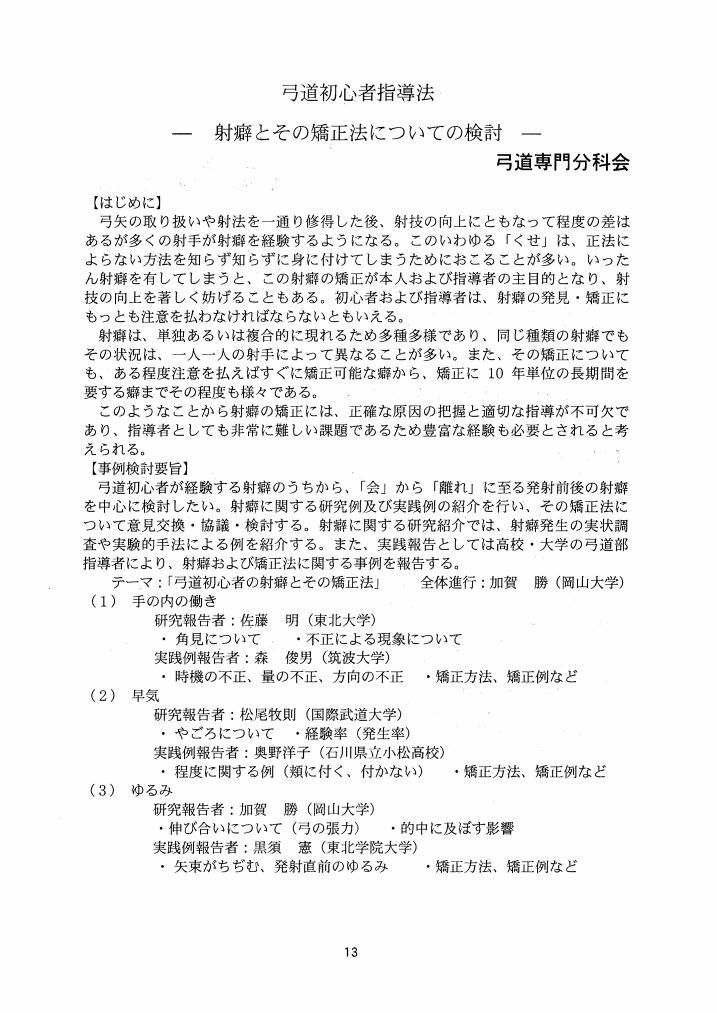- 著者
- 稲垣 源四郎 細谷 聡
- 出版者
- 日本武道学会
- 雑誌
- 武道学研究 (ISSN:02879700)
- 巻号頁・発行日
- vol.21, no.2, pp.55-56, 1988
1 0 0 0 OA 自由民権期における警察武術について
- 著者
- 湯浅 晃
- 出版者
- 日本武道学会
- 雑誌
- 武道学研究 (ISSN:02879700)
- 巻号頁・発行日
- vol.33, no.Supplement, pp.5-5, 2000 (Released:2012-11-27)
1 0 0 0 OA 「古式の形」の研究― 甲冑着用の場合
1 0 0 0 OA 中世における修験道の刀剣観に関する一考察
- 著者
- 酒井 利信
- 出版者
- 日本武道学会
- 雑誌
- 武道学研究 (ISSN:02879700)
- 巻号頁・発行日
- vol.23, no.2, pp.61-62, 1990-11-30 (Released:2012-11-27)
1 0 0 0 OA 空手道専門分科会企画
1 0 0 0 OA 剣道選手の脳運動準備電位― Topography法による検討―
1 0 0 0 OA 学生弓道における選手育成の問題
1 0 0 0 OA 競技記録による学生弓道団体戦の分析
1 0 0 0 OA 弓道における的中記録簿の利用
1 0 0 0 柔道投技の巴投に関する運動力学的研究
- 著者
- エクストン マテュー・ 井浦 吉彦
- 出版者
- 日本武道学会
- 雑誌
- 武道学研究 (ISSN:02879700)
- 巻号頁・発行日
- vol.23, no.3, pp.24-34, 1991
本研究は,柔道の投技のうち巴投を採り上げ,基本的施技方法と応用的施技方法で体重の異なる3名の相手を投げた場合の動作を,映像と圧電式加速度計を用いて分析し,柔道の投技のメカニズムを明らかにすることを目的とした。<br>実験は1987年1月,イギリスにおいて行い,映像と圧電式加速度計から異なる方法で施技される巴投の動作中の重心位置,慣性モーメント,角変位,角速度,角運動量を求め,比較検討した。得られた結果は下記の通りである。<br>1.基本的巴投の施技中における3名の受の重心移動は,ほぼ同様の傾向を示した。<br>2.基本的巴投の施技中における3名の受の慣性モーメントにおいて,軽量及び中量の受は同じ傾向を示したが,重量の受は,異なる傾向を示した。また,最高値は重量,中量,軽量の1順であり,慣性モーメントが体重に比例することを裏付けた。<br>3.基本的巴投の施技中における3名の受の角速度では,何れも2層曲線を形成するという点では一致したが,時間的変化及び値に違いがみられた。<br>4.基本的巴投の施技中における取の角運動量は,いわゆる「つくり」の局面で最小を示し,「掛け」の局面の直後で最大を示した。<br>5.中量の受における角速度の比較では,基本的巴投に比べ,相手を急激に引く動作を伴う応用的巴投に著しい角速度変化及び角速度の増加による施技時間の短縮がみられた。<br>6.圧電式加速度計による比較では,基本的巴投及び応用的巴投ともほぼ同様な傾向を示したものの,取の動作中の「つくり」の局面において,基本的巴投では相手を引くと同時に脚の屈曲がみられるが,応用的巴投では相手を引いた後暫くしてから脚の屈曲がみられた。
1 0 0 0 OA 正身・正息の理
- 著者
- 佐藤 通次
- 出版者
- 日本武道学会
- 雑誌
- 武道学研究 (ISSN:02879700)
- 巻号頁・発行日
- vol.10, no.3, pp.1-6, 1978-03-05 (Released:2012-11-27)
1 0 0 0 OA 弓道古伝書射法と現代射法の差異並びにその起因について
- 著者
- 稲垣 源四郎
- 出版者
- 日本武道学会
- 雑誌
- 武道学研究 (ISSN:02879700)
- 巻号頁・発行日
- vol.9, no.2, pp.28-30, 1976-11-30 (Released:2012-11-27)
- 参考文献数
- 8
1 0 0 0 OA 弓道初心者指導方法に関する検討会
- 出版者
- 日本武道学会
- 雑誌
- 武道学研究 (ISSN:02879700)
- 巻号頁・発行日
- vol.33, no.Supplement, pp.14-14, 2000 (Released:2012-11-27)
1 0 0 0 記紀神話にみられる弓矢について
- 著者
- 酒井 利信
- 出版者
- 日本武道学会
- 雑誌
- 武道学研究 (ISSN:02879700)
- 巻号頁・発行日
- vol.39, no.2, pp.1-15, 2006
- 被引用文献数
- 1
This research aims to clarify the magical power of the bow and arrow that appear in ancient Japanese myths, including <i>'Kojiki'</i>and' <i>Nihon shoki</i>.'<br>In my the previous study, I clarified the following in relation to the magical power of the sword that appears in ancient Japanese myths:<br>1. the magical power of the sword<br>2. the relationship between the sword and gods (when discussing the magical power of the sword, the sword must be sacred; this is the basis of why the sword is sacred)<br>3. the attribute of the sword that connects the celestial world of the gods and the terrestrial world of human beings (this provides an assumption for the relationship between the sword and the gods).<br>In this research, I investigated whether the magical power of the bow and arrow has the same structure as that of the sword, by comparing the findings of the previous study, and confirmed the following:<br>In the myth of Arnenowakahiko, three points were found: 1. the magical power of the bow and arrow; 2. the relationship between the gods and the bow and arrow; and 3. the bow and arrow's attribute connecting between the celestial world of the gods and the terrestrial world of human beings, suggesting that the magical power of the bow and arrow has the same structure as that of the sword.· A difference from the magical power of the sword was revealed in the myth of Ninuriya.·Besides the magical power of Hekija (exorcising evil gods and demons), I found the magical power of Seisei (creating).·Although arrows themselves originally had magical power, the red color of Ninuziya represents the magical power of the blood, by which the magical power of the arrow was enhanced.·In the Ninuriya myth, I could not find the magical power of the bow, but found only the magical power of the arrow.·In the Ninuriya myth, the arrow flows down the river to the terrestrial world as the god's incarnation. This implies that the world of gods lies in the horizontal direction of the terrestrial world. However, in the Kilo myths a view of the world is expressed in a form that basically stands solid in the vertical direction. The sword and arrow of the Arnenowakahiko myth connected the celestial world of the gods to the human world on Earth. The view of the world in this vertical direction was, however, created by a new ideology, and the world view was originally horizontal. The arrow was previously understood as something that connected the comparatively old transcendence axis in the horizontal direction.
1 0 0 0 記紀神話にみられる弓矢について
- 著者
- 酒井 利信
- 出版者
- 日本武道学会
- 雑誌
- 武道学研究 (ISSN:02879700)
- 巻号頁・発行日
- vol.39, no.2, pp.1-15, 2006
This research aims to clarify the magical power of the bow and arrow that appear in ancient Japanese myths, including <i>‘Kojiki’</i>and‘ <i>Nihon shoki</i>.’<br>In my the previous study, I clarified the following in relation to the magical power of the sword that appears in ancient Japanese myths:<br>1. the magical power of the sword<br>2. the relationship between the sword and gods (when discussing the magical power of the sword, the sword must be sacred; this is the basis of why the sword is sacred)<br>3. the attribute of the sword that connects the celestial world of the gods and the terrestrial world of human beings (this provides an assumption for the relationship between the sword and the gods).<br>In this research, I investigated whether the magical power of the bow and arrow has the same structure as that of the sword, by comparing the findings of the previous study, and confirmed the following:<br>In the myth of Arnenowakahiko, three points were found: 1. the magical power of the bow and arrow; 2. the relationship between the gods and the bow and arrow; and 3. the bow and arrow's attribute connecting between the celestial world of the gods and the terrestrial world of human beings, suggesting that the magical power of the bow and arrow has the same structure as that of the sword.· A difference from the magical power of the sword was revealed in the myth of Ninuriya.·Besides the magical power of Hekija (exorcising evil gods and demons), I found the magical power of Seisei (creating).·Although arrows themselves originally had magical power, the red color of Ninuziya represents the magical power of the blood, by which the magical power of the arrow was enhanced.·In the Ninuriya myth, I could not find the magical power of the bow, but found only the magical power of the arrow.·In the Ninuriya myth, the arrow flows down the river to the terrestrial world as the god's incarnation. This implies that the world of gods lies in the horizontal direction of the terrestrial world. However, in the Kilo myths a view of the world is expressed in a form that basically stands solid in the vertical direction. The sword and arrow of the Arnenowakahiko myth connected the celestial world of the gods to the human world on Earth. The view of the world in this vertical direction was, however, created by a new ideology, and the world view was originally horizontal. The arrow was previously understood as something that connected the comparatively old transcendence axis in the horizontal direction.
1 0 0 0 OA 大学体育授業における合気道のラーニングアウトカムとは?
- 著者
- 園部 豊
- 出版者
- 日本武道学会
- 雑誌
- 武道学研究 (ISSN:02879700)
- 巻号頁・発行日
- vol.46, no.Supplement, pp.123-123, 2013 (Released:2014-09-10)
1 0 0 0 OA 弓道初心者の指導と意識に関する研究
- 著者
- 弘瀬 公雄 森 俊男
- 出版者
- 日本武道学会
- 雑誌
- 武道学研究 (ISSN:02879700)
- 巻号頁・発行日
- vol.29, no.Supplement, pp.35-35, 1996 (Released:2012-11-27)
1 0 0 0 OA 弓道初心者指導法―射癖とその矯正法についての検討―
- 出版者
- 日本武道学会
- 雑誌
- 武道学研究 (ISSN:02879700)
- 巻号頁・発行日
- vol.34, no.Supplement, pp.13-13, 2001 (Released:2012-11-27)
1 0 0 0 OA 弓道の上肢筋電図
- 著者
- 佐藤 明
- 出版者
- 日本武道学会
- 雑誌
- 武道学研究 (ISSN:02879700)
- 巻号頁・発行日
- vol.43, no.Supplement, pp.21, 2010 (Released:2014-04-04)














